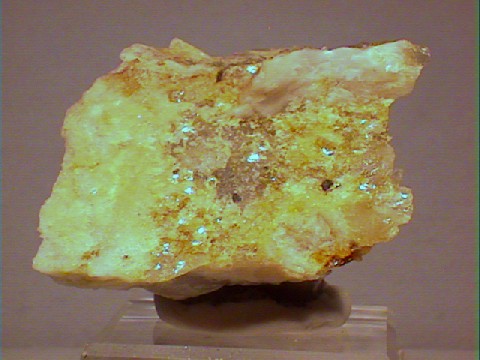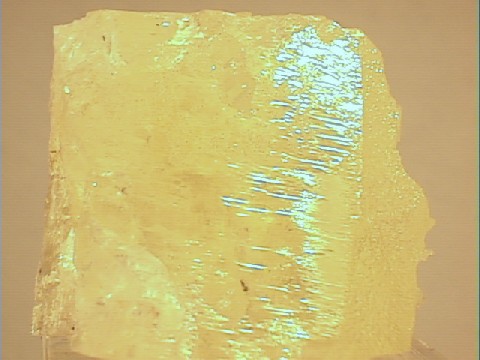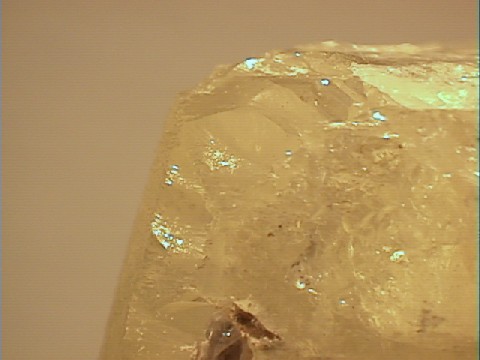 THE
MINERAL AMBLYGONITE
THE
MINERAL AMBLYGONITE
- Chemistry: (Li, Na)AlPO4(F, OH), Lithium Sodium Aluminum Phosphate Fluoride Hydroxide.
- Class: Phosphates
- Group: Amblygonite
- Uses: As a source of lithium and phosphorus, as gemstones and as mineral specimens.
Specimens
Amblygonite is a relatively common phosphate mineral. It is found in lithium and phosphate rich pegmatites as a primary mineral. At times it makes up a significant percentage of the rock although this fact may be overlooked. Amblygonite, as it turns out, is easily confused for other host rock members such as quartz and albite. The general appearance of amblygonite does resemble these two minerals especially the albite but it can be differentiated with a flame test for lithium, density and by its unusual cleavage.
Amblygonite's name comes from the Greek words for "blunt angles" in allusion to its variously angled cleavages. Amblygonite has no less than four different directions of cleavage at different angles from one another and with different qualities of cleavage. This is very different from quartz which has no cleavage and albite which has only two directions of cleavage at nearly 90 degrees.
Amblygonite has a fairly compact structure. This fact gives rise to a somewhat high specific gravity. Of course a specific gravity of around 3.05 is not considered very high in the mineral kingdom. But a look at amblygonite's formula shows the elements sodium, lithium, aluminum, hydrogen, fluorine, oxygen and phosphorous. None of these elements are heavy and a mineral composed of these elements would be expected to have a specific gravity lower than 3. Both quartz and albite have lower specific gravities than amblygonite.
Since amblygonite has lithium in its formula, it gives a reliable lithium result with a flame test. Powdered amblygonite which is placed in a gas flame will produce a brightly colored red flame. This is evidence for the presence of lithium.
In amblygonite's chemistry, the lithium and sodium substitute for each
other but there is a greater percentage of lithium than sodium. A mineral
with the same structure and chemistry as amblygonite but with more sodium
than lithium is called
Gem quality amblygonite is mined in Brazil and the regions formerly known as Burma. These gems are an attractive yellow color and have an index of refraction of 1.61 and 1.64. This is a relatively low index of refraction but is higher than beryl or quartz and on par with topaz and tourmaline.
Amblygonite, montebrasite, natramblygonite, natromontebrasite,
and a mineral named
PHYSICAL CHARACTERISTICS OF AMBLYGONITE:
- Color is generally white or creamy, but can also be colorless or pale yellow, green, blue, beige, gray or pink.
- Luster is vitreous to greasy and pearly on cleavage surfaces.
- Transparency: Specimens are translucent to less commonly transparent.
- Crystal System is triclinic, bar 1.
- Crystal Habits include short prismatic, tabular or equant crystals referred to as lath-shaped, but more commonly found as anhedral masses and compact grains. Twinning forms elongated, flatten crystals. Lamellar twinning is sometimes seen.
- Cleavage is in four directions all with varying quality with one direction being perfect, two directions being good and one direction being only distinct. All cleavage angles are non-right angles.
- Fracture is uneven to conchoidal.
- Hardness is 5.5 - 6
- Specific Gravity is approximately 2.98 - 3.11 (slightly above average).
- Streak is white.
- Other Characteristics: When powdered and placed in a gas flame, it gives the flame a bright red color and this indicates the presence of lithium. Some specimens are fluorescent orange in long-wave UV light.
- Associated Minerals include lepidolite, quartz, albite, elbaite, topaz, cassiterite, apatite, brazilianite, beryllonite, montebrasite, triphylite, lithiophilite and spodumene
- Notable Occurrences are Minas Gerais, Brazil; Montebras, France; Germany; Varutrask, Sweden; Sakangyi, Burma; Yellowknife, Northwest Territories, Canada. In the United States localities include Pala District of San Diego County, California; Newry, Hebron, Buckfield and Topsham, Maine; Taos County, New Mexico; Yavapai County, Arizona and the Black Hills area of South Dakota.
- Best Field Indicators are density, associations, environment, lithium flame test and especially the numerous cleavage angles.





